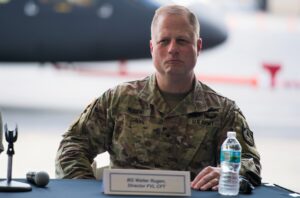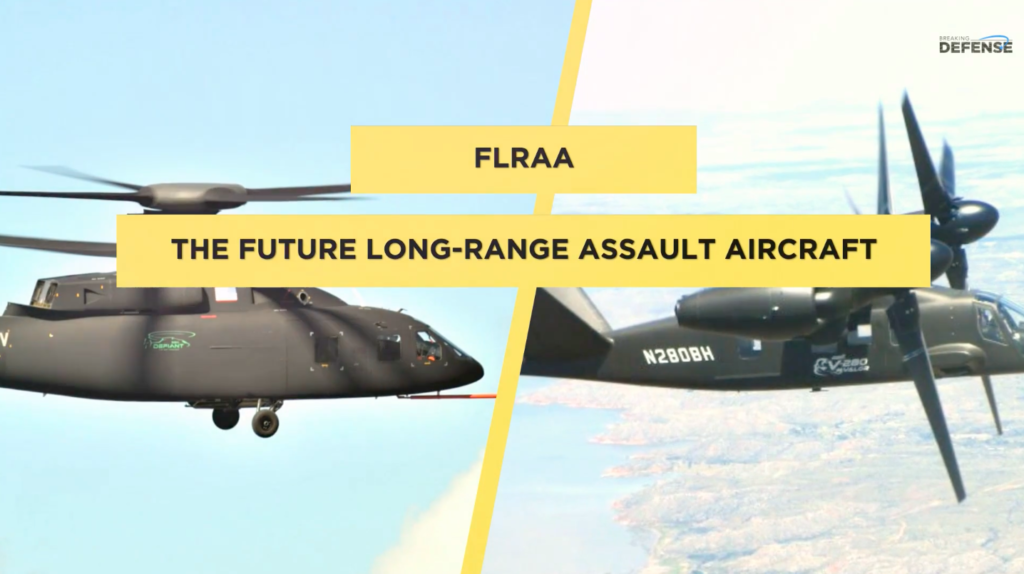
The Sikorsky Raider-X (left) and the Bell 360 Invictus (right)
WASHINGTON: Despite disruptions due to COVID-19, development of the Future Vertical Lift family of manned and unmanned aircraft remains on track, Army officials tell me.
“COVID continues to throw us curveballs; so far we’ve been able to hit them,” said Brig. Gen. Walter Rugen, the FVL director at Army Futures Command. “Sometimes we’re hitting singles and bunting and doing a lot of hard work to score runs.”

Brig. Gen. Walter Rugen
Rugen and his acquisition corps counterpart – Brig. Gen. Robert Barrie, the Program Executive Officer for Aviation – oversee the simultaneous development of two different manned aircraft, two types of drones, a host of supporting systems from engines to guns, and a shared Modular Open Systems Architecture (MOSA) meant to ensure all these technologies are compatible and interconnected. (A third type of drone, the Advanced UAS, remains in the concept stage). The two men updated me recently on FVL progress, since the normal briefings at this week’s AUSA conference were largely curtailed by COVID.
The most urgent program in the portfolio is the Future Attack Reconnaissance Aircraft (FARA), a high-speed light scout to replace the retired OH-58 Kiowa. The two contenders, Bell (part of Textron) and Sikorsky (Lockheed Martin), are about to submit their final designs.
“Our Final Design & Risk Review comes in November of this year,” Barrie told me. After that, he said, “those competitive prototype designs will be locked.”

Brig. Gen. Robert Barrie
Even though those designs aren’t 100 percent, both competitors have already started building their FARA prototypes. Work began this week on the Bell 360 Invictus, the company told me; that’s rapid, considering that the company only unveiled the winged helicopter design last fall. But Sikorsky is arguably ahead: The Lockheed subsidiary says it began building components of its Raider-X, a compound helicopter, way back in 2019, even before it was awarded a contract to build the prototype – and Raider-X derives from the company-funded S-97 Raider, which has been flying and racking up test data for five years.
Both competitors must be ready to fly by the fall of 2022 (the first quarter of fiscal year 2023), with the Army picking a winner in 2023. Those are deadlines not only for Bell and Sikorsky, but also for the Army, which is providing major portions of both aircraft as Government-Furnished Equipment:
- Both aircraft will be armed with a new 20mm cannon, the General Dynamics XM915, which will start live-fire testing this month at Ethan Allen Test Range in Vermont, before moving to Aberdeen Proving Ground in Maryland. “We’re going to shoot a couple hundred thousand rounds through that,” Rugen said.
- Both aircraft will also carry a Modular Effects Launcher now being developed to launch, not just missiles and rockets, but multi-purpose mini-drones called Air-Launched Effects (ALE). In August, the Army awarded 10 contracts for different aspects of ALE: Three companies are competing to build the drone itself, three are competing for the digital mission system architecture, and four are building different payloads. The Modular Effects Launcher, meanwhile, should be ready for flight test next year – installed on a surrogate aircraft, since the FARA prototypes will still be under construction – when it will be used in October’s Project Convergence 21 wargames.
- Both aircraft will be powered by the General Electric’s T901 Improved Turbine Engine, which will also be retrofitted to existing helicopters. GE won the engine contract last year and is still finalizing their design. “This summer, despite many challenges with COVID, we’ve been able to execute a Critical Design Review,” Barrie told me, with the first full-up engine beginning testing late next year.
One crucial component, however, will not be fully ready when FARA begins its flight tests in late 2022: the Modular Open System Architecture.
MOSA isn’t a physical component of an aircraft, but a set of standards and interfaces that define how all the components work together. The idea is to ensure all the electronics on all the different FVL aircraft, not just FARA, are not only compatible with each other but easy to upgrade. Rather than pay the Original Equipment Manufacturer (OEM) to laboriously integrate new technology, as happens today, Army should be able to swap in new components from competing manufacturers at will, as long as they all comply with MOSA standards.

Army Predator variant (MQ-1C Grey Eagle) armed with Hellfire missiles
The Army’s already tested a very early version of MOSA on modified MQ-1C Grey Eagle drones during experiments in 2019 and 2020 at China Lake, Ca. and Yuma, Ariz. “We were able to put 27 technologies very rapidly onto Gray Eagle, without going back to the OEM,” Rugen told me, and without having to recertify the aircraft as safe to fly each time, since MOSA lets the flight controls stay unchanged even as other components are replaced.
But the Army wants to scale MOSA up from two dozen technologies on one type of drone to hundreds of technologies across all the manned and unmanned aircraft – not only in the Future Vertical Lift family, but in the existing fleet, using an upgrade called the Avion Mission Common Sever (AMCS) to let you plug MOSA-compliant components into existing Black Hawks, Apaches, and Chinooks.
Making all those different pieces fit together is a tremendous task.
MOSA is “one of the most challenging things we have do,” Barrie told me, less because of the technology itself than because of all the independent actors who must sign on. The official Architecture Collaboration Working Group, which brings together companies, universities, and government agencies to work on MOSA, has over 400 members.
“It’s not necessarily challenging technically,” Barrie told me. “We can describe interfaces and standards that exist [already]. What we’re focusing on is how do we do governance.”
MOSA has made major progress in the last six months, Rugen said, with increasingly enthusiastic participation from industry and increasing consensus on how it should work. But the architecture will not be complete until after the FARA prototype designs are locked later this year.
“There’s no doubt we’re challenged on schedule,” Barrie acknowledged. “Those competitive prototypes [for FARA] will have some instantiation of an open system approach.” But it’s too early to say how advanced that version of MOSA will actually be, or how much revision it will require before FARA is ready to enter mass production.
“We have not yet described here’s exactly how we’re going to do systems integration,” Barrie said. “We don’t want to yet constrain the problem.”

Sikorsky-Boeing SB>1 Defiant compound helicopter (left) and Bell Textron V-280 Valor tiltrotor (right)
Instead, the Army will ask companies to propose their own rival versions of MOSA, as part of the competition for the Future Long-Range Assault Aircraft (FLRAA), the FVL replacement for the Black Hawk. The formal Request For Proposals (RFP) for FLRAA will come out later this year.
How well each competing proposal handles MOSA “will be a critical aspect of how we determine which FLRAA competitor we eventually go with,” Barrie said.
The two leading competitors for FLRAA are, once again, Sikorsky – this time teamed with Boeing – and Bell. Bell’s prototype is V-280 Valor, a tiltrotor derived from the V-22 Osprey: Valor has been in flight tests since late 2017, racking up over 180 flight hours and exceeding the 280 knot (322 mph) top speed for which it’s named. Sikorsky and Boeing, by contrast, are playing catchup: Their SB>1 Defiant has 23 flight hours so far – plus hundred more in ground tests and simulations – and has reached a speed of 211 knots (242 mph) in level flight.
Even as flight tests on the prototypes continue, both companies are now developing their final designs for FLRAA. The Army is set to pick a winner in 2022.






















